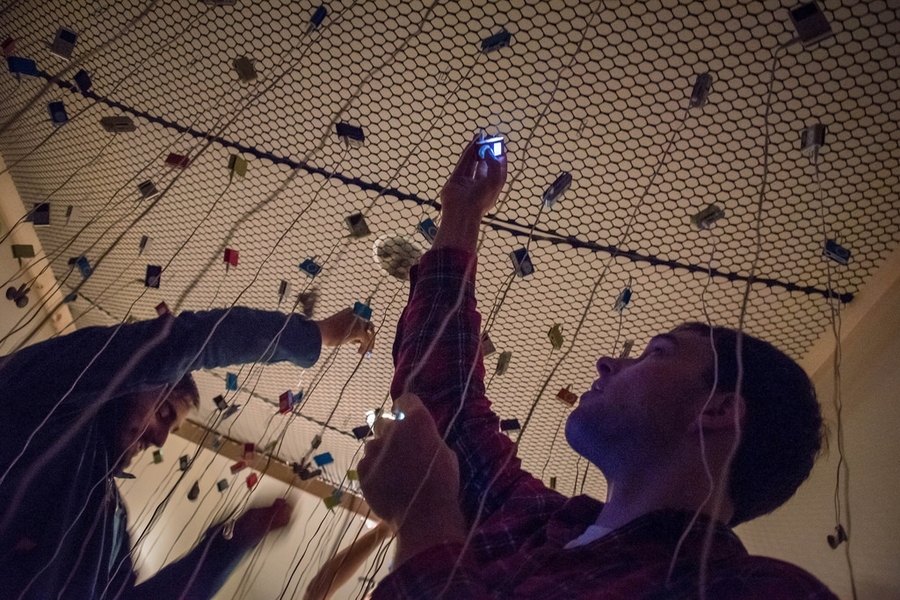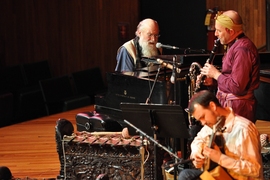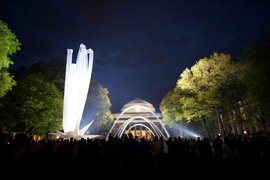The MIT Center for Art, Science and Technology (CAST) has received $1.5 million from the Andrew W. Mellon Foundation, in support of the center’s role as a catalyst for multidisciplinary creative experimentation and integration of the arts across all areas of MIT. The recent grant brings the Mellon Foundation’s total support for CAST to $3 million, among the largest gifts received by the Arts at MIT.
Philip S. Khoury, associate provost, expressed gratitude for the Mellon Foundation’s ongoing support and recognition: “The Mellon Foundation has an unparalleled role in funding pioneering programs in the arts and humanities, and this gift is a wonderful affirmation of the role of the Arts at MIT, CAST’s mission, and of the Institute’s distinctive arts heritage. We are enormously grateful for the Mellon’s ongoing support, which will enable us to expand the vital work of the Center.”
CAST promotes research, teaching, and programming at the intersections of art, science, and engineering. The center brings outstanding artists to campus as co-creators with faculty and students and sponsors a biennial, international symposium focused upon interrelated, mutually informing modes of exploration, knowledge, and discovery in various domains of the arts and sciences. Since its inception in 2012, CAST has provided grants for more than 20 artist residencies and collaborative projects with MIT faculty and students, 12 cross-disciplinary courses and workshops, two concert series, and numerous multimedia projects, lectures, and symposia.
CAST builds upon MIT’s 50 years of imaginative, forward-thinking approaches to integrating the arts into a research institution renowned for science and engineering. György Kepes established the Center for Advanced Visual Studies (CAVS) in 1967, a highly influential program that first brought artists, scientists, and engineers together in a research environment. CAVS pioneered the practice of “art on a civic scale,” which is today a cornerstone of the Program in Art, Culture and Technology (ACT) in the School of Architecture and Planning. Jerome B. Wiesner, the 13th president of MIT, fostered a multimedia program in the arts at MIT, firmly grounded in teaching and research at the Institute. He established the Council for the Arts at MIT in 1974, one of the first organizations of its kind in a U.S. university, and his support led to the establishment of the List Visual Arts Center and the MIT Media Laboratory.
Evan Ziporyn, the Kenan Sahin Distinguished Professor of Music and faculty director of the center, says, “CAST has taken the creative culture of the Institute as a whole and provided it with a solid and supportive framework, bolstering the implicit connection between the rigors of artistic practice and those of the laboratory and design studio.”
CAST programs
MIT has long been home to a broad range of artistic activities and is particularly known for its strong music and performing arts programs. Its faculty include Pulitzer Prize winners in music and fiction, and world-class performers and directors. Nearly half of all science and engineering undergraduate students enroll in music and theater classes each academic year. The campus is a hub of contemporary musical experimentation and innovation, where new work is commissioned, composed, and presented throughout the year.
MIT Sounding, a CAST performance series launched this year, includes new work commissioned by MIT and has already reinvigorated Boston’s musical landscape. Described as “welcome and ambitious” by The Boston Globe’s Jeremy Eichler, MIT Sounding included performances this season by legendary composer Alvin Lucier, Grammy-winners Roomful of Teeth, sound artist Arnold Dreyblatt, as well as several new works commissioned by MIT. The season concluded with a celebratory concert in honor of composer Terry Riley on April 18, which featured performances by Riley himself and an international cast of supporters, including 20 saxophonists in the world premiere of a re-imagined version of Riley's classic "Poppy Nogood."
The 2015-16 season will preview a new opera from composer Keeril Makan and director Jay Scheib, based on Ingmar Berman’s film "Persona," as well as performances by Maya Beiser, the Flux Quartet, and Pamela Z.
In addition to presenting new work, CAST’s Visiting Artists Program brings contemporary artists to campus to engage with groundbreaking research in the sciences and engineering, which frequently results in the development of new media and technologies for artistic expression. According to CAST executive director Leila Kinney, “The program is distinctive for its emphasis on the research and development phase of artistic work and the openness of scientists and engineers to artists’ speculative but hands-on way of thinking.”
Collaborative research into materials and media
Tomás Saraceno, visiting artist at CAST since 2012, has for some years investigated the complex morphology of spider webs and certain species’ ability to remain airborne to traverse great distances, which in turn has inspired large-scale installations, presented as speculative models for alternative ways of living. Fascinated by cosmologists’ reference to “black widow” pulsars in describing the behavior of certain stars in the wake of the big bang, Saraceno used a laser to scan a black widow spiderweb and has created three-dimensional installations from the data — for example, "14 Billions (Working Title)," 2010. In addition, he has used spiders as the “co-creators” of luminous silk sculptures, whose complex geometries are woven by multiple species in the controlled environment of his studio. Saraceno’s work has dovetailed with the research of MIT professor and Department of Civil and Environmental Engineering head Markus Buehler, who studies the molecular structure of proteins in spider silk and the forces in spider webs in search of synthetic, bio-inspired building materials (see “Reverberations: Spiders and Musical Webs”). Saraceno will discuss the vision, arachnology, structural ingenuity, and collaborative research that inform the installations created with spider webs now on exhibit in New York at MIT’s “Active Matter Summit” April 24-25.
For a recent exhibition at The Kitchen in New York City, artist Anicka Yi worked with Tal Danino, a postdoctoral fellow at the MIT Laboratory for Multiscale Regenerative Technologies, to develop strange and pungent works cultured into a “collective bacterium.” Yi and Danino, a recent TED Fellow, created a scent from biological samples of 100 women to explore ideas related to paranoia surrounding contagion and hygiene, fear of feminism, and the power of female networks. “[This residency] really opened the gates for me,” Yi said in an interview in ArtSpace, “to have the opportunity to develop relationships with some of the top researchers and scientists. And then the biology started to become more tangible.” Yi returns to MIT for an exhibition at the List Visual Arts Center opening May 22.
Known for her Emmy Award-winning multimedia project, "Highrise," about life in residential skyscrapers throughout the world, documentarian Katerina Cizek recently completed a two-year residency sponsored by CAST at the MIT Open Documentary Lab. The latest phase of the project, "Highrise: Digital Citizenship," examines how new technologies and modes of communication shape residents’ personal and political lives. She will premiere the final chapter of the acclaimed digital documentary project as a multimedia participatory event, "Highrise: Universe Within, Live," at HotDocs, the Canadian International Documentary Festival, and will launch this pioneering project as a Web documentary later this year. “I am so excited for this opportunity and have so much gratitude to MIT that it exists,” Cizek said.
CAST supports cross-disciplinary curricular initiatives that integrate the arts into the core curriculum and create new opportunities for students to work between and across various fields of inquiry, such as 4.110J / MAS.330J / MAS.650J (Design Across Scales and Disciplines), taught by J. Meejin Yoon, professor and head of the Department of Architeture, and Neri Oxman, the Sony Corporation Career Development Professor of Media Arts and Sciences.
This semester, Skylar Tibbits, research scientist and director of the Self-Assembly Lab, is teaching a new CAST-sponsored studio that fuses materials science, art, and design with the emergent field of self-generating and programmable materials. Using the assembly language Processing, students created “generative” drawings, based on the structural properties of various material precedents, then exploited those principles by experimenting with physical embodiments of them in materials as divergent as glass, foam, and candy. In a final exercise, students will work in teams to create large-scale installations based on their discoveries, developing design strategies informed by these new technologies for fabrication.
A two-day symposium held in conjunction with this studio will bring together experts from art, design, materials science, engineering, and industry. The “Active Matter Summit” will showcase and help define the emerging field of programmable materials and build a strong community that can collectively explore challenges, applications, and future scenarios in this domain. As Tibbits has observed, “We can listen to materials and use them as a programmable material. We can program biology.”
Neri Oxman is the MIT Media Lab representative in the Active Matter Summit who works at the intersections of computational design, additive manufacturing, and synthetic biology. “We live in a special time in history — a rare time,” says Oxman. She notes that the confluence of these fields is giving designers access to new tools and, along with them, new ways of seeing and making. At the recent TED Conference in Vancouver, Oxman revealed a first-of-its-kind photosynthetic wearable 3-D printed with fluidic channels infused with living matter. She suggests: “Think of it not as evolution by natural selection but evolution by design.”
CAST’s 2016 symposium, “Material Worlds” will explore these developments in materials systems and design — including self assembly, programmable matter, transformable structures, design with biological materials — and what cultural historians call a “new materialism.” Each biennale symposium will build upon an area of expertise and significant research at MIT, by introducing insights from leading artists and humanities scholars into the dialogue, as in the successful 2014 symposium “Seeing / Sounding / Sensing,” which convened artists, scientists and humanists for a dialogue about the arts and cognitive sciences.
At MIT, artists have embraced the challenge of inventing new methods, media, and technologies for artistic production alongside the goal of creating the most expressive artifacts, performances, and buildings. Operating at the vanguard of research into new artistic materials and methods, CAST is poised to advance the Institute’s leadership in innovation. These explorations in turn will determine the artistic and performative languages of the 21st century.









